First Drive: 2011 Chevrolet Volt

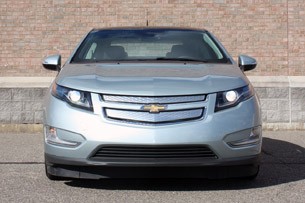

The look of the Volt is less round than the pill-shaped Toyota Prius and Honda Insight, but if you squint just right you’ll see they all cut the same basic profile. This was dramatically displayed when GM gave us a tour of the Hamtramck, Michigan, plant in which the car is assembled (right next to Buick Lucernes and Cadillac DTSes) and we saw the Volt bodies without their distinctive black plastic trim that runs underneath the side windows.
GM stylists have done an admirable job of making the Volt seem more sedan-like, so as not to appear as yet another Prius imitator, like the Insight. This is accomplished by accentuating the length of the car, both with the black lower window trim and a character line that runs across the lower half of both doors. Headlights and taillights that wrap into thin side-marker lights help too. On the street, however, the car still doesn’t stand out much from any number of nondescript compacts.



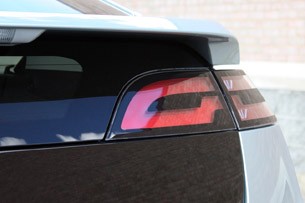
GM didn’t give us a number for interior volume, but the Volt is adequately sized for four adults, save for a lack of rear headroom. When you’re sitting inside it, the Volt feels more cramped than a Prius, as it suffers from some common GM syndromes: a high belt line, wide pillars, thick doors and a relatively low roof. Numbers bear this out, as the Prius bests the Volt in both headroom and legroom. The Volt is by no means as claustrophobia-inducing as a sports car, but you’d never describe it as “roomy.”
The Volt won’t impress with the quality of its interior materials either, which are merely adequate if you judge against other compacts, and downright cheap looking if you put them up against what you’ll find in other $40,000 cars. The backseat gets the worst of it, as the center console running between the two rear buckets is an edifice of monotone hard plastic, as are the rear door panels. That rear console isn’t there just for cupholders, as it’s hiding the T-shaped battery pack that’s positioned exactly where the driveshaft tunnel in a front-engine, rear-wheel-drive car would be.
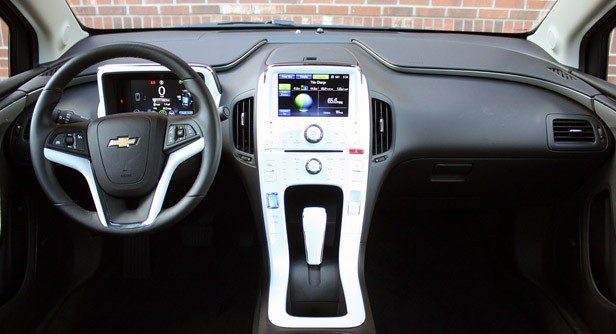



Up front the interior quality improves a bit, as the doors are at least trimmed with inset panels. There are softer finishes on two sculpted pads that break up the large flat surface on top of the dashboard too. Even so, you can be certain that nobody is going to confuse the Volt with a luxury car.
Leather seats are one of the few Volt options (the others being a rear camera with parking assist, special paint and polished wheels), and picking this $1,395 trim package certainly makes the interior a bit easier on the eyes. We didn’t mind driving a Volt with base cloth, as it does its job in providing an acceptable covering for the manually adjustable seats, which seemed comfortable and supportive. Our drive time was limited to 150 miles over two days, so any final analysis on seating comfort will have to be reserved for later. Perhaps the best reason to opt for leather is to remedy the horrid base trim steering wheel. GM keeps swearing it has learned not to spec this sort of unpleasant rubbery plastic for a high-touch part, but clearly that wasn’t the case with the Volt.


Rather, GM seems to have dropped most of its interior budget into Volt’s two seven-inch LCD screens. The first resides in front of the steering wheel and encompasses all of the information the driver would typically see on the instrument panel, like speed and fuel level. This display is configurable via a knob and two buttons to the left of the wheel. A touch screen for the navigation, audio and climate control systems, which also acts as the interface for much of the electronic geekery associated with the car’s drive system, sits conventionally atop the center stack. For the most part, the graphics and information displayed on these screens is first-rate, including a neat little animation of the electrical flow similar to what’s found in the Prius.
While there are a few physical buttons on the metallic white center stack (including the electric parking brake, a door lock button and the “leaf” button that changes the car’s drive mode from Normal to Sport) most of the controls for the stereo and such are touch sensitive. The white plastic of the center stack makes for a pretty cool look, and the quality of the smooth finish is excellent, better than on any other surface in the car.
The white color also extends to the gearshift lever, but this is another aspect of the Volt that’s poorly executed. The lever is oversized and in Park sits in a cutout underneath the center stack. The problem is, there’s not enough clearance around the shifter, so it’s awkward to manipulate. Drivers with sausage fingers may find themselves scraping knuckles and we can imagine problems for people who wear rings, as well.
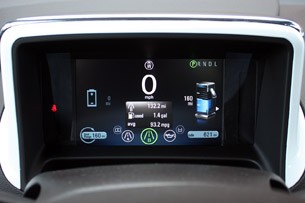



In most vehicles, the engine features prominently. Yet with the Volt, GM really wishes we’d forget about the 84-horsepower, 1.4-liter, iron block four-cylinder that’s fitted under the hood. The General likes to call this premium fuel-burning unit lifted from the company’s European parts bin a “generator,” but the truth is that the gas engine is actually clutched to a 55-kw electric generator in the Volt’s transaxle.
This is one of two such motors that reside there, the other being the 111-kw traction motor that provides the primary drive power for the Volt in EV mode. But the traction motor is not the only source of motive power, as the electric motor generator can be lashed together with the traction motor by way of the Volt transmission’s planetary gearset, to allow both motors to turn the wheels of the car for better electrical efficiency. Of note is that the generator can provide electricity for both the battery pack and directly to the traction motor, depending on circumstances.
If you do forget about the gasoline engine in the Volt – because you’re one of the 80 percent of Americans that GM says can have all of their daily driver needs met with the Volt’s 40-ish-mile electric range – the sedan will actually remind you to run the gas engine and, if you don’t, it will kick it on for you. It does this to combat the fuel growing stale, something that shows just how far GM has thought through all the “what-ifs” of the Volt.

This is just one of many impressive design details that bear mention. Here are a few examples: Mountain Mode forces the gasoline engine to turn on and charge up the battery to a higher level in anticipation of heading up a steep grade. Additionally, GM has equipped the car with a pedestrian awareness alert to make up for how quiet it is in EV mode, and if you flash the brights at speeds under 40 mph, the car will gently honk the horn automatically.
As unique as some of the Volt’s features are, it uses a pretty normal suspension adapted from the Cruze. Up front you’ll find MacPherson struts and an anti-sway bar, while in the rear there’s a torsion beam arrangement. The Volt has anti-lock brakes, traction control and stability control, as you’d expect of any modern car. Power steering is electric, which brings up another interesting point: The accessories in the Volt all run on a standard 12-volt automotive circuit.
While the Volt does have a conventional 12-volt battery, it’s just there to operate the remote door locks and provide the initial power to boot the computer that will then switch on the main battery pack after it passes its self-test. Instead of using an alternator, the Volt steps down the high voltage current from its main battery pack to supply the 12-volt juice.


While it’s easy to get lost in the hows and whys of the Volt’s technology, what’s truly impressive is that the car performs flawlessly. GM has gone to great – even excessive – lengths to make the Volt as mainstream as it can. There’s a shallow learning curve to operation, which mostly surrounds finding the green-glowing start button on the center stack near the shifter and dropping the bulky, console-mounted unit into drive. After that, the experience has a lot in common with piloting a four-cylinder Chevy Malibu. In our test drive, we couldn’t turn up anything that made us feel the Volt’s development was incomplete.
But as much as driving the Volt is not so different from driving a regular gasoline-powered car, at the same time, it is. First there’s the lack of noise, which is easy enough to get used to. To be expected, the Volt is as whisper-quiet as the most expensive luxury sedan when it’s in EV mode. But even when driving in extended-range mode, most of the time you’ll be hard-pressed to really notice the gasoline engine revving up. Then there’s the lack of drama from the transmission, which we couldn’t really feel doing much of anything in any mode, despite the knowledge that it had to be doing something. What it wasn’t doing was producing that rubber-band acceleration effect of most hybrids, where you can really feel the electric assist kicking in. Power delivery in the Volt is consistent and predictably tied to what your right foot is doing.
You can really feel that GM tried to make acceleration at part-throttle mimic that of a car with a conventional automatic transmission, which is to say, the throttle response is a bit soft, which, no doubt, improves efficiency. Yet driving more aggressively can yield a pretty engaging experience, as GM says the car can do 0-60 miles per hour in less than nine seconds — accomplished in Sport mode, which improves throttle response a bit. Eight seconds and change seems like an entirely reasonable estimate based on our time behind the wheel. At higher speeds, up to and over 80 miles per hour, the Volt feels confident and tracks well, and it never feels sluggish if you’re willing to work the throttle. If there’s any disappointment in the electric drive experience, it’s that even in Sport mode the initial throttle response is not as immediate as we imagine it could be.
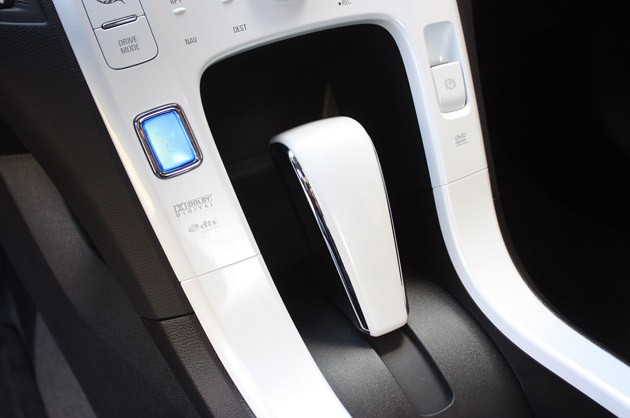
If you want to turn up the dial another notch beyond just putting the car into Sport, you can shift it into what we’ve dubbed “Tesla mode.” Selecting “L” with the gearshift lever forces the car to use its maximum regenerative braking ability. While the normal regenerative braking is perfectly calibrated to feel like the engine braking of a vehicle with an internal combustion engine, and gives the brakes a great, solid feeling, the max-regen mode slows the car dramatically, immediately upon lifting your foot from the throttle. While the 3,781-pound Volt is never going to feel like a sports car, with the drive mode in Sport and the shifter in “L,” there is some fun to be had.
Handling is better than expected, thanks in part to the Volt’s low center of gravity. While this is a heavy car by any metric, the batteries are mounted low enough in the chassis that when the Volt leans in the corners it never feels unplanted and the weight shift is easy enough to control. Most of the feedback you’ll get during such maneuvers will come through your seat, however, as the Volt’s steering is numb at speed, which we suppose is better than the over-assisted feeling it has in parking lots. To keep the Volt feeling securely planted even when it’s being pushed, GM has equipped the vehicle with 215/55R17 Goodyears. While these are low-rolling-resistance tires, what’s notable here is that they’re fairly wide. Not too long ago, sports sedans were routinely shod with similar sized tires.
One of the biggest unanswered questions about the Volt is its fuel economy, and if ever there has been a vehicle for which the “you mileage may vary” caveat applies, this is it. GM and the Environmental Protection Agency are still negotiating over how the Volt’s fuel economy will be displayed on its window sticker when it goes on sale, but it’s likely that the results of those discussions aren’t going to be particularly informative to customers anyway. Trying to compare the efficiency of internal-combustion vehicles with plug-in hybrids and electric vehicles is an apples-to-oranges endeavor, as it depends so dramatically on each driver’s particular use pattern.

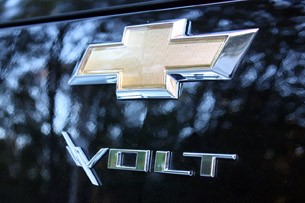
In our first stint in the Volt, we were able to stretch the range of the battery pack to 47.5 miles – and the Volt’s sophisticated battery-level meter still showed 10 miles of range remaining. (We accomplished this by driving in “L” all the time and accelerating about as slowly as possible without disrupting traffic.) GM tells us it spent huge amounts of time in development making sure this “fuel gauge” was absolutely accurate. When you first start the Volt it displays your range based on the past week of driving, and once underway, it performs its projected range calculations based on the last four miles of driving. The next day we drove over 100 miles – receiving a partial charge at a stop about halfway – and were in extended-range mode for about half of our time.
While our drive wasn’t long enough to gather any empirical data beyond the 36 mpg displayed on the Volt’s trip computer when we finished, we can do some math. GM gave us official numbers that we can use to make two reasonable estimates. The Volt has a 9.3-gallon gas tank, and GM states that the range in extended-range mode is approximately 310 miles. That means the Volt should return around 33 miles per gallon, after its EV range of roughly 40 miles is exhausted. And if you get in your fully-charged Volt and drive it until the tank runs dry, you’ll see about 38 miles per gallon overall. Given that GM had been bandying about a 50 mpg number – not-coincidentally matching the Prius – this is nothing short of disappointing.
That said, the Volt will still allow its owners to achieve whatever fuel economy they desire by limiting the use of the car in extended-range mode. This is the key to wrapping your mind around the Volt. Other hybrids are principally powered by their gasoline engines and use electric power in a strictly supplementary role. Even the forthcoming Prius plug-in will operate in this fashion, which is why its EV mode is limited in acceleration and top speed.

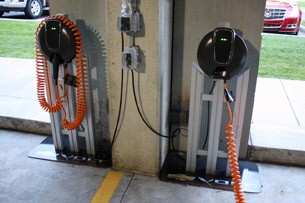
The Volt, however, uses electric drive power nearly all of the time, so it’s really designed to be driven for shorter distances and recharged, like a full battery-electric. GM says the Volt can be completely recharged in about four hours if you get an optional 240-volt charger installed, or 10-12 hours plugged into a standard wall jack. Charging the Volt is a simple process that’s not all that different from plugging in a cell phone; the Volt even has a light on the dashboard that glows yellow when its charging and turns green when finished.
While your average disinterested driver can hop in the Volt and not feel intimidated by all the engineering wizardry – or find themselves stranded with a dead battery – at its core the Volt is a car for engineering geeks and technology nerds who will, no doubt, enjoy exploring every last capability of its unique drivetrain.
You’ve got to give GM credit for building this thing, especially during the most miserable turn of events in the company’s long and storied history. With a donated body architecture, an engine designed for an entirely different application and a transmission built from parts left over from a canceled hybrid vehicle program, the final Volt still seems a bit of a science fair project. Albeit, one pieced together by talented engineers, at least one of them eager to vindicate the company’s failed EV1 electric car program with a success.
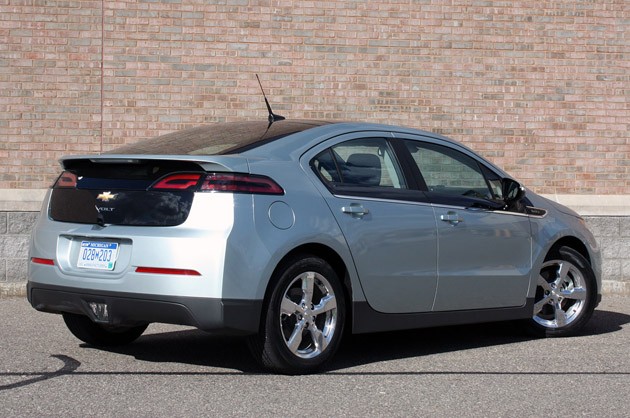
Yet the big question remains: Can the Volt go mainstream? GM has said it intends to build 45,000 Volts per year starting in 2012. That’s not a small number of cars, not when they’re priced at $40,280. Even if you deduct potential tax credits of at least $7,500 from the Federal government, or opt for the $350/month lease “deal,” this is a costlier-than-average car. While former GM CEO Rick Wagoner liked to compare the Volt’s development to NASA’s Apollo program, there’s a huge difference between developing an amazing piece of technology and commercializing it – and it’s not like you can drive a Volt to the moon.
GM’s pitch to consumers is that the Volt is “More Car Than Electric,” the tagline of its forthcoming ad campaign. Its marketing will be focused on the fact that the Volt is a do-everything car that has none of the limitations of pure battery-electrics, thanks to its gas engine. But the fact remains that anyone buying a Volt is going to have to do the same self-analysis of their driving patterns and habits that they would if they were considering a Nissan Leaf electric or a plug-in Toyota Prius or even a regular hybrid.
GM would like to think it’s thought of everything with the Volt, and covered every contingency, and from what we’ve seen, that’s true. But there’s one crucial thing they can’t engineer in, and that’s public acceptance.




